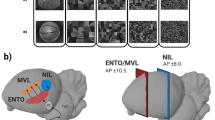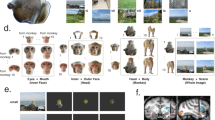Abstract
Robust form perception and underlying neuronal mechanisms require generalized representation of object boundaries, independent of how they are defined. One visual ability essential for form perception is reconstruction of contours absent from the retinal image. Here we show that barn owls perceive subjective contours defined by grating gaps and phase-shifted abutting gratings. Moreover, single-neuron recordings from visual forebrain (visual Wulst) of awake, behaving birds revealed a high proportion of neurons signaling such subjective contours, independent of local stimulus attributes. These data suggest that the visual Wulst is important in contour-based form perception and exhibits a functional complexity analogous to mammalian extrastriate cortex.
This is a preview of subscription content, access via your institution
Access options
Subscribe to this journal
Receive 12 print issues and online access
$209.00 per year
only $17.42 per issue
Buy this article
- Purchase on Springer Link
- Instant access to full article PDF
Prices may be subject to local taxes which are calculated during checkout





Similar content being viewed by others
References
Kanizsa, G. Organization in Vision. Essays on Gestalt Perception (Praeger, New York, 1979).
Schumann, F. Beitraege zur analyse der gesichtswahrnehmungen. erste abhandlung. einige beobachtungen ueber die zusammenfassung von gesichtseindruecken zu einheiten. Z. Psychol. Physiol. Sinnesorgane 23, 1 –32 (1990).
Petry, S. & Meyer, G. E. The Perception of Illusory Contours (Springer, New York, 1987).
Ramachandran, V. S. in The Perception of Illusory Contours (eds. Petry, S. & Meyer, G. E.) 93–108 (Springer, New York, 1987).
Paradiso, M. A., Shimojo, S. & Nakayama, K. Subjective contours, tilt aftereffects, and visual cortical organization. Vision Res. 29, 1205– 1213 (1989).
von der Heydt, R. in The Cognitive Neurosciences (ed. Gazzaniga, M. S.) 365–382 (MIT Press, Cambridge, Massachusetts, 1995).
Gregory, R. L. Cognitive contours. Nature 238, 51– 52 (1972).
Rock, I. & Anson, R. Illusory contours as the solution to a problem. Perception 8, 665– 681 (1979).
Van Essen, D. C. & DeYoe, E. A. in The Cognitive Neurosciences (ed. Gazzaniga, M. S.) 383–400 (MIT Press, Cambridge, Massachusetts, 1995).
Hubel, D. H. & Wiesel, T. N. Receptive fields and functional architecture of monkey striate cortex. J. Physiol. (Lond.) 195, 215–243 (1968).
Karten, H. J., Hodos, W., Nauta, W. J. & Revzin, A. M. Neural connections of the 'visual Wulst' of the avian telencephalon. Experimental studies in the pigeon (Columba livia) and owl (Speotyto cunicularia). J. Comp. Neurol. 150, 253–278 (1973).
Pettigrew, J. D. Binocular visual processing in the owl's telencephalon. Proc. R. Soc. Lond. B Biol. Sci. 204, 435–454 (1979).
Casini, G., Fontanesi, G. & Bagnoli, P. in Vision, Brain, and Behavior in Birds(eds. Zeigler, H. P. & Bischof, H.-J.) 159–169 (MIT Press, Cambridge, Massachusetts, 1993).
Pettigrew, J. D. in Visual Neuroscience (eds. Pettigrew, J. D., Sanderson, K. J. & Levick, W. R.) 208–222 (Cambridge Univ. Press, Cambridge, 1986).
Shimizu, T., Cox, K. & Karten, H. J. Intratelencephalic projections of the visual Wulst in pigeons (Columba livia). J. Comp. Neurol. 359 , 551–572 (1995).
Pettigrew, J. D. & Konishi, M. Neurons selective for orientation and binocular disparity in the visual Wulst of the barn owl (Tyto alba). Science 193, 675– 678 (1976).
Spillmann, L. & Werner, J. S. Long-range interactions in visual perception. Trends Neurosci. 19, 428– 434 (1996).
Gilbert, C. D., Das, A., Ito, M., Kapadia, M. & Westheimer, G. Spatial integration and cortical dynamics. Proc. Natl. Acad. Sci. USA 93, 615– 622 (1996).
Shimizu, T. & Karten, H. J. in Vision, Brain, and Behavior in Birds(eds. Zeigler, H. P. & Bischof, H.-J.) 103– 114 (MIT Press, Cambridge, Massachusetts, 1993).
Nieder, A. & Klump, G. M. Adjustable frequency selectivity of auditory forebrain neurons recorded in a freely moving songbird via radiotelemetry. Hear. Res. 127, 41–54 (1999).
Grosof, D. H., Shapley, R. M. & Hawken, M. J. Macaque V1 neurons can signal 'illusory' contours. Nature 365, 550–552 (1993).
Peterhans, E. Functional organization of area V2 in the awake monkey. Cereb. Cortex 12, 335–357 ( 1997).
Bravo, M., Blake, R. & Morrison, S. Cats see subjective contours. Vision Res. 28, 861–865 ( 1988).
De Weerd, P., Vandenbussche, E., De Bruyn, B. & Orban, G. A. Illusory contour orientation discrimination in the cat. Behav. Brain Res. 39, 1–17 ( 1990).
van Hateren, J. H., Srinivasan, M. V. & Wait, P. B. Pattern recognition in bees: orientation discrimination . J. Comp. Physiol. A 167, 649– 654 (1990).
van der Willigen, R. F., Frost, B. J. & Wagner, H. Stereoscopic depth perception in the owl. Neuroreport 9, 1233–1237 (1998).
Sheth, B. R., Sharma, J., Rao, S. C. & Sur, M. Orientation maps of subjective contours in visual cortex. Science 274, 2110–2115 (1996).
von der Heydt, R., Peterhans, E. & Baumgartner, G. Illusory contours and cortical neuron responses. Science 224, 1260–1262 ( 1984).
von der Heydt, R. & Peterhans, E. Mechanisms of contour perception in monkey visual cortex. I. Lines of pattern discontinuity. J. Neurosci. 9, 1731–1748 (1989).
Lamme, V. A., Zipser, K. & Spekreijse, H. Figure-ground activity in primary visual cortex is suppressed by anesthesia. Proc. Natl. Acad. Sci. USA 95, 3263–3268 (1998).
Grossberg, S. & Mingolla, E. in The Perception of Illusory Contours (eds. Petry, S. & Meyer, G. E.) 116–125 (Springer, New York, 1987).
De Weerd, P., Desimone, R. & Ungerleider, L. G. Cue-dependent deficits in grating orientation discrimination after V4 lesions in macaques. Vis. Neurosci. 13, 529–538 (1996).
Steinbach, M. & Money, K. E. Eye movements of the owl. Vision Res. 13, 889–891 (1973).
Acknowledgements
We are grateful to R. v.d.Willigen for introduction to graphics programming. B. Gaese provided a clocked-sequence program for data collection. We thankB. Gaese and H. Luksch for suggestions on an earlier version of the manuscript and M. Schäfer for help with data analysis. Supported by a grant from the DFG to H.W. (WA 606/6).
Author information
Authors and Affiliations
Corresponding author
Rights and permissions
About this article
Cite this article
Nieder, A., Wagner, H. Perception and neuronal coding of subjective contours in the owl. Nat Neurosci 2, 660–663 (1999). https://doi.org/10.1038/10217
Received:
Accepted:
Issue Date:
DOI: https://doi.org/10.1038/10217
This article is cited by
-
Visual categories and concepts in the avian brain
Animal Cognition (2023)
-
Neurons in the pigeon visual network discriminate between faces, scrambled faces, and sine grating images
Scientific Reports (2022)
-
Morphology, biochemistry and connectivity of Cluster N and the hippocampal formation in a migratory bird
Brain Structure and Function (2022)
-
Everything is subjective under water surface, too: visual illusions in fish
Animal Cognition (2020)
-
Interactions between top-down and bottom-up attention in barn owls (Tyto alba)
Animal Cognition (2018)



